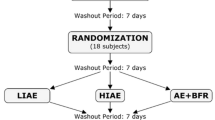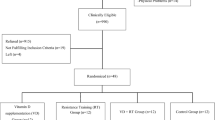Abstract
There is a relationship between high levels of inflammatory markers and low adhesion to the practice of physical activity in the older population. The objective of the present study was to compare the effect of two types of exercise programs, i.e., aerobic training and aerobic plus resistance training on the plasma levels of interleukin-6 (IL-6) and tumor necrosis factor alpha (TNF-α) of elderly hypertensive subjects. Hypertensive older volunteers in use of antihypertensive drugs were randomized to three groups: aerobic group (AG), resistance and aerobic group (RAG) and control group (CG). Training lasted 10 weeks, with sessions held three times a week. Blood samples were collected before training and 24 h after completion of the 30 sessions for the determination of serum IL-6 and TNF-α levels. Body mass index was obtained before and after 10 weeks. After intervention, BMI values were lower in AG and RAG compared to CG (p < 0.001), IL-6 was reduced in AG compared to CG (p = 0.04), and TNF-α levels were lower only in RAG compared to CG (p = 0.01). Concluding, both types of training were effective in reducing BMI values in hypertensive older subjects. Aerobic exercise produced the reduction of plasma IL-6 levels. However, the combination of aerobic and resistance exercise, which would be more indicated for the prevention of loss of functionality with aging, showed lower TNF-α mediator after training than control group and a greater fall of TNF-α levels associated to higher BMI reduction.



Similar content being viewed by others
References
Veras RP, Ramos LR, Kalache A (1987) Growth of the elderly population in Brazil: changes and consequences in society. Rev Saude Publica 21:225–233
Effros RB (2007) The role of T lymphocytes in replicative senescence and efficacy of vaccines. Vacina 25:599–607. doi:10.1016/j.vaccine.2006.08.032
Roubenoff R (2003) Catabolism of aging: is it inflammatory process? Curr Opin Clin Nutr Metab Care 6:295–299. doi:10.1097/01.mco.0000068965.34812.62
Pereira DS, Queiroz BZ, Mateo EC, Assumpção AM, Felício DC, Miranda AS, Anjos DM, Jesus-Moraleida F, Dias RC, Pereira DA, Teixeira AL, Pereira LS (2012) Interaction between cytokine gene polymorphisms and the effect of physical exercise on clinical and inflammatory parameters in older women: study protocol for a randomized controlled trial. Trials 13:134. doi:10.1186/1745-6215-13-134
Santos RV, Viana VA, Boscolo RA, Marques VG, Santana MG, Lira FS, Tufik S, de Mello MT (2012) Moderate exercise training modulates cytokine profile and sleep in elderly people. Cytokine 60:731–735. doi:10.1016/j.cyto.2012.07.028
Bautmans I, Gorus E, Njemini R, Mets T (2007) Handgrip performance in relation to self-perceived fatigue, physical functioning and circulating IL-6 in elderly persons without inflammation. BMC Geriatr 7:5. doi:10.1186/1471-2318-7-5
Haddad F, Zaldivar F, Cooper DM, Adams GR (2005) IL-6-induced skeletal muscle atrophy. J Appl Physiol 98:911–917. doi:10.1152/japplphysiol.01026.2004
Schaap LA, Pluijm SM, Deeg DJ, Visser M (2006) Inflammatory markers and loss of muscle mass (sarcopenia) and strength. Am J Med 119:526.e9–526.e17. doi:10.1016/j.amjmed.2005.10.049
Beavers KM, Hsu HR, Isom S, Kritchevsky SB, Church T, Goodpaster B, Pahor M, Nicklas BJ (2010) Long-term physical activity and inflammatory biomarkers in older adults. Med Sci Sports Exer 42:2189–2196. doi:10.1249/MSS.0b013e3181e3ac80
Brinkley TE, Leng X, Miller ME (2009) Chronic inflammation is associates with low physical function in older adults across multiple comorbidities. J Gerontol B Psychol Sci Soc Sci 64:455–461. doi:10.1093/gerona/gln038
Pedersen BK (2009) The diseasome of physical inactivity—and the role of myokines in muscle—fat cross talk. J Physiol 587:5559–5568. doi:10.1113/jphysiol.2009.179515
Pedersen BK, Febbraio MA (2008) Muscle as an endocrine organ: focus on muscle derived interleukin-6. Physiol Rev 88:1379–1406. doi:10.1152/physrev.90100.2007
American College of Sports Medicine (2007) ACSM’s guidelines for exercise testing and prescription, 7th edn. Guanabara Koogan, Rio de Janeiro, p 216
Borg CAV (1982) Psychophysical bases of perceived exertion. Med Sci Sports Exer 14:377–381
SAS Institute Inc (1999) SAS/STAT® User’s Guide. Version 9.0. SAS Institute Inc, Cary
Fischer CP (2006) Interleukin-6 in acute exercise and training: what is the biological relevance? Exer Immunol Rev 12:6–33
Keller C, Steensberg A, Hansen AK, Fischer CP, Plomgaard P, Pedersen BK (2005) The effect of exercise, training, and glycogen availability on IL-6 receptor expression in human skeletal muscle. J Appl Physiol 99:2075–2079. doi:10.1152/japplphysiol.00590.2005
Pedersen BK, Steensberg A, Schjerling P (2001) Muscle-derived interleukin-6: possible biological effects. J Physiol 536:329–337. doi:10.1111/j.1469-7793.2001.0329c.xd
Pedersen BK, Steensberg A, Fischer C, Keller C, Keller P, Plomgaard P, Febbraio M, Saltin B (2003) Searching for the exercise factor: is IL-6 a candidate? J Muscle Res Cell Motil 24:113–119
Petersen AM, Pedersen BK (2005) The anti-inflammatory effect of exercise. J Appl Physiol 98:1154–1162. doi:10.1152/japplphysiol.00164.2004
Kohut ML, McCann DA, Russell DW, Konopka DN, Cunnick JE, Franke WD, Castillo MC, Reighard AE, Vanderah E (2006) Aerobic exercise, but not flexibility/resistance exercise, reduces serum IL-18, CRP, and IL-6 independent of beta-blockers, BMI, and psychosocial factors in older adults. Brain Behav Immun 20:201–209. doi:10.1016/j.bbi.2005.12.002
Oberbach A, Lehmann S, Kirsch K, Sonnabend M, Linke A, Tönjes A, Stumvoll M, Blüher M, Kovacs P (2008) Long-term exercise training decreases interleukin-6 (IL-6) serum levels in subjects with impaired glucose tolerance: effect of the -174G/C variant in IL-6 gene. Eur J Endocrinol 159:129–136. doi:10.1530/EJE-08-0220
Lambert CP, Wright NR, Finck BN, Villareal DT (2008) Exercise but not diet-induced weight loss decreases skeletal muscle inflammatory gene expression in frail obese elderly persons. J Appl Physiol 105:473–478. doi:10.1152/japplphysiol.00006.2008
Beavers KM, Ambrosius WT, Nicklas BJ, Rejeski WJ (2013) Independent and combined effects of physical activity and weight loss on inflammatory biomarkers in overweight and obese older adults. J Am Geriatr Soc 61:1089–1094. doi:10.1111/jgs.12321
Nicklas BJ, Hsu HR, Brinkley TJ, Church T, Goodpaster BH, Kritchevsky SB, Pahor M (2008) Exercise training and plasma C-reactive protein and interleukin-6 in elderly people. J Am Geriatr Soc 56:2045–2052. doi:10.1111/j.1532-5415.2008.01994.x
Lustosa LP, Máximo Pereira LS, Coelho FM, Pereira DS, Silva JP, Parentoni AN, Dias RC, Domingues Dias JM (2013) Impact of an exercise program on muscular and functional performance and plasma levels of interleukin 6 and soluble receptor tumor necrosis factor in prefrail community-dwelling older women: a randomized controlled trial. Arch Phys Med Rehab 94:660–666. doi:10.1016/j.apmr.2012.11.013
Acknowledgments
This study was supported by the Research Foundation of the State of São Paulo (FAPESP) and the National Council for Scientific and Technological Development (CNPq).
Conflict of interest
Authors declare no conflict of interest.
Author information
Authors and Affiliations
Corresponding author
Rights and permissions
About this article
Cite this article
Lima, L.G., Bonardi, J.M.T., Campos, G.O. et al. Effect of aerobic training and aerobic and resistance training on the inflammatory status of hypertensive older adults. Aging Clin Exp Res 27, 483–489 (2015). https://doi.org/10.1007/s40520-014-0307-y
Received:
Accepted:
Published:
Issue Date:
DOI: https://doi.org/10.1007/s40520-014-0307-y




